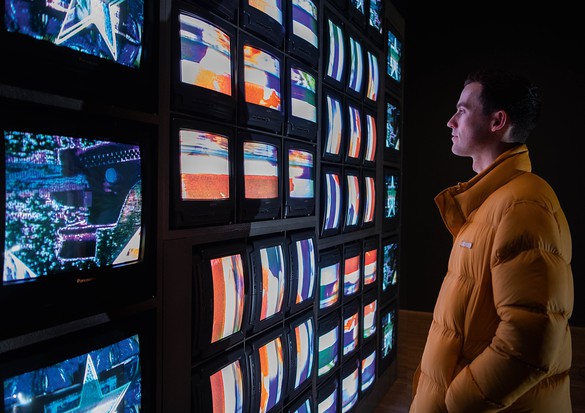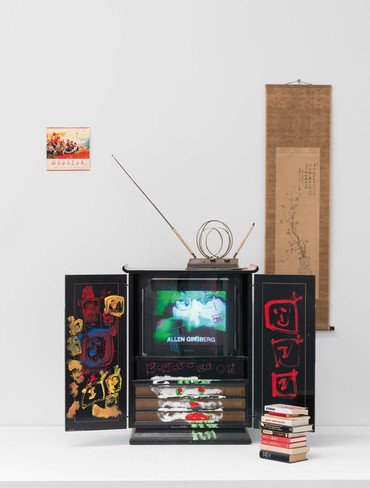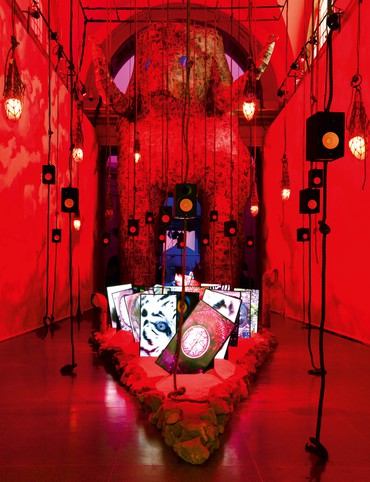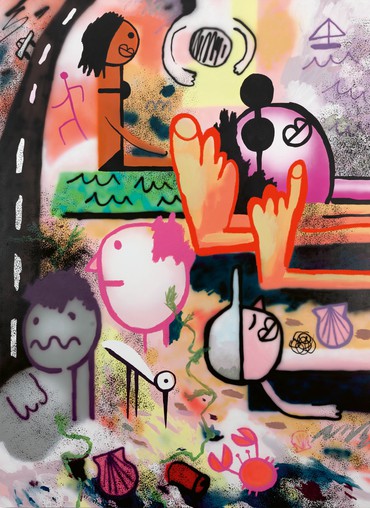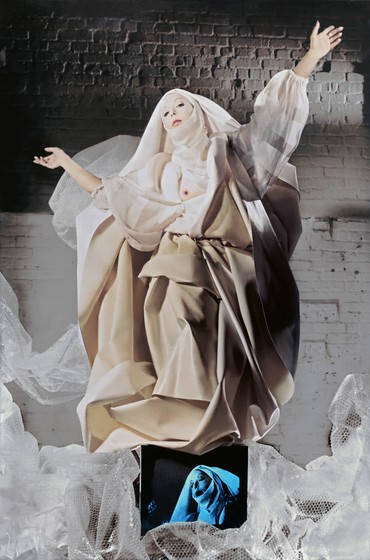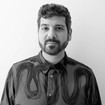
Dr. Omar Kholeif is an author, curator, broadcaster, and cultural historian who currently serves as Director of Collections and Senior Curator at Sharjah Art Foundation, UAE. Born in Cairo to Egyptian and Sudanese parents, Kholeif has curated over seventy exhibitions of visual art and has authored or coauthored over forty books, which collectively have been translated into twelve languages.

Ashley Overbeek is the director of strategic initiatives at Gagosian, where she has the pleasure of working with artists on Web3 and digital projects. Overbeek is also an advisory-board member of the Art and Antiquities Blockchain Consortium, a 501c3 nonprofit, and a guest speaker on the subject of art and blockchain technology at Stanford and Columbia University.
Ashley OverbeekOmar, it’s great to be able to chat with you about your new book, Internet_Art, published by Phaidon this spring. Since so much of my own work focuses on the relatively recent advent of crypto art, I’m excited to look back at the beginnings of the internet art movement with you. Could you tell me a little about the book’s title?
Omar KholeifThank you, me too. The underscore between “internet” and “art” is crucial in that the book is very much about how the internet has grown to underscore all aspects of artmaking, and, indeed, of cultural production. The artist Lawrence Abu Hamdan once asked me, Is the internet the electricity of our time? To a large extent, my answer is yes. It is a medium, i.e., it is a thing, but it is also a space, and a concept, that has engendered its own set of possibilities—aesthetic, social, political, and otherwise.
AOYou describe the internet as “a connective tissue that binds and fragments us as humans.” Given a concept as broad and seemingly paradoxical as the internet, how does one wrap a definition around internet art? Do we look to subject matter or medium? Or perhaps we should be thinking in altogether different terms?
OKI like the way you frame this question. Precedent isn’t always useful when attempting to decode something, particularly the history of such a mutable context. The internet is expansive, as you suggest, but it is also very specific. One could reduce it to “the mains,” or “the network of all networks,” or simply a set of wires and cables that connect to other wires and cables. But the possibilities engendered by those wires and cables, and the attendant technologies, in turn produce specific cultural movements that I’ve been interested in ever since I began learning how to use a computer.
I’ve spent the better part of two decades attempting to constellate knowledge around this field. In 2013 I published an anthology, You Are Here: Art After the Internet, that demonstrated the thirst of multiple publics for this kind of writing. It also revealed the necessity for a live, critical, and insider take on what was happening to art with all these technological shifts occurring. The internet was becoming used as a metaphor—but why? And why a metaphor that didn’t necessarily seem to make sense? Artists were tinkering with the parameters of the internet as a field and expanding it as a concept, learning new languages that seemed alien to the general populace. Someone had to try to mediate this, and that journey is what I’ve sought to narrate.
The way I decided to structure the book in turn was as a social history—a historical record told through the memoir form. The book maps the key changes in my life and career against the seemingly chaotic realm of art and culture that emerged in relation to the internet. What I believe I’ve put into the world, or hope to have anyway, is a historical document that we can learn from. A way to claim firsthand experience observing and decoding the present in order to comprehend the broad ocular shifts in art and society today.
AOOf course, we can’t talk about internet art without referencing the pioneering artist Nam June Paik, who is credited with coining the phrase “electronic superhighway” as early as 1974. As we reflect on the many works within his Electronic Superhighway series, it’s uncanny how prescient the themes of technology-facilitated human interconnectedness have been.
OKNam June Paik has been a pivotal figure for me ever since I was a child. Partly because, like me, he was a nonwhite immigrant living in the so-called West who was exploring the limits and parameters of technology. My new book even begins with his saying “The Future Is Now,” which was also the title of a conference on Paik’s legacy that I convened in 2012.
My interest in Paik is mapped out in Internet_Art, as well as through the many journeys and returns across my career. The 1974 paper, commissioned by the Pew Charitable Trusts, in which he coined the term “electronic superhighway” created the framework for an exhibition I curated at the Whitechapel Gallery, London, in 2016, which has now been dubbed “pathbreaking” and which traveled the world. The show was called Electronic Superhighway (2016–1966): From Experiments in Art and Technology to Art After the Internet. Presented in reverse chronological order, the exhibition sought to create a connective tissue between the activities of E.A.T. (Experiments in Art and Technology), in which Paik was deeply involved and which began one year before the internet was first realized as an idea by ARPA [the US Advanced Research Projects Agency] in 1967, and the present day of hypermedia saturation and hyperlinked consciousness.
It was widely argued that Electronic Superhighway (2016–1966) was the first museum exhibition to narrate the expanse of this history, and this was certainly the show’s goal. It succeeded in spreading awareness of Paik’s influence but also in reorienting contemporary discourses into the realm of a longer genealogy of art history, which also included Paik’s collaborations with the likes of Allan Kaprow, John Cage, Charlotte Moorman, and many others. A key point that I wanted to make with the exhibition was that the internet was not born in a day. And neither was the WWW [World Wide Web], which Tim Berners-Lee dreamed up and announced while working at CERN [the Conseil Européen pour la Recherche Nucléaire] in 1989. Indeed, a decentralized and networked world has been a dream for many for generations. But how does this technology come to be? And what can we make of it? At the Whitechapel I exhibited several works by Paik but anchored the show with his landmark 1994 installation Internet Dream. I had discovered this work when I was curator at the Foundation for Art and Creative Technology, Liverpool, where I was involved in Paik’s first survey since his death, in 2006.
I also recently curated My Life in the Metaverse, at Manarat Al Saadiyat, near the Louvre Abu Dhabi. I began the exhibition with one of Nam June Paik’s TV Buddha sculptures, precisely because they too were first produced in 1974 and because they foreshadow the selfie culture of today. The work was a sensorial obsession, especially for younger visitors, and I am delighted and honored to be able to have helped to bring it to one of the UAE’s significant public collections for posterity’s sake.
AOIn what ways have later internet artists reinterpreted and broadened this idea of technological connectivity?
OKIt really depends on what you mean by “later.” I have closely examined but also lived this history of art on, with, and through the internet. And the artists who walked in Paik’s or in Andy Warhol’s footsteps, for example, were making work while both of these figures were still alive. None of these practices emerged in a vacuum. What occurred is that artists with different skill sets and aesthetic sensibilities came to the fore seeking to expand the possibilities of the field. In 1998, for example, Shu Lea Cheang famously created Brandon, a web-based artwork and installation for the Guggenheim in New York, which sought to explore different facets of how social justice and LGBTQI+ histories could be explored, narrated, and presented. Collectives such as dis returned us to Warhol’s Interview magazine and Keith Haring’s Pop Shop while creating a network of community-oriented actors around them, exploding the parameters of art and culture. Lizzie Fitch and Ryan Trecartin expanded the hyperlinked contours of video and cinema, while Jordan Wolfson has confronted us with the moral and ethical implications of robotics and virtual reality. Pivotally, all of these things are indeed connected to one another. They all form part of a spiral of history that continues to loop.
AOCyborgs represent a literal combination of humanity and technology. Your book discusses several internet artists—Lynn Hershman Leeson, Mireille Porte (ORLAN), Neil Harbisson, and Wafaa Bilal—who have approached this concept of hybridity, though in very different ways. Could you expand on each artist’s approach?
OKGrowing up, I was obsessed with the movie Blade Runner [1982] and the concept of replicants. We have now passed the year 2019, the future in which the film had been set over thirty years earlier, so I went to one of the locations where it was shot, the Bonaventure Hotel in Los Angeles, to reflect and write the final chapter of my book. It was in the midst of the pandemic and a strange incident occurred that is narrated in the book—a power cut that left hundreds of people struggling to move up and down the floors of this tower. What I realized in this moment was that we have all somehow become replicants, interdependent with networked devices that have affected our consciousness, fostering a heightened state of anxiety. The artists you refer to were exploring these contours and limits early on, fostering discourse that is only truly being understood and examined for its significance today.
AOCould you tell me more about the exhibition Art in the Age of Anxiety? You curated it during the COVID-19 pandemic, when we were all collectively forced to confront the advantages and limitations of technology.
OKThis was the third of a trilogy of exhibitions that began with Electronic Superhighway (2016–1966) and continued with I Was Raised on the Internet at the Museum of Contemporary Art Chicago. Art in the Age of Anxiety was commissioned by the Sharjah Art Foundation, UAE, and was the largest exhibition of its kind in the region. I was living and working in the United Arab Emirates full-time at that point, and I was in love with the cyberpunk city before me but also constantly fretful, teetering on the edge.
I wanted to create an exhibition that explored how the internet and its attendant technologies had fashioned a hyperconsciousness, what I call an “age of feeling,” propelled by the possibilities of these technologies. To create the scenography for the exhibition, I invited architect, author, and former Yale professor Todd Reisz to conceive of a cellular architecture that I said should make you feel like you’re being funneled down a fiber-optic cable. The show was designed in dozens of shades of gray and luminescent surfaces that mirrored cable coverings. The walls were rarely straight, and artworks were staged to be encountered in a singular and confrontational way whereby one would be made to feel complicit in the context and making of the show. Through artworks by the likes of Tabor Robak and Siebren Versteeg, I used Art in the Age of Anxiety to reveal how news headlines spoon-feed us the necessary emotional feed that we desire. Through installations by Eva and Franco Mattes, Jeremy Bailey, Antoine Catala, and many others, I examined the embodiment of digital aesthetics, such as memes.
As we were installing the show, rumblings grew that something was literally in the air. Artists asked if they could postpone their flights; eventually every single artist canceled their visit. I was so worried—I wanted to be with my family, but I was told that it was incredibly unlikely that nearby Dubai International, the busiest long-haul airport in the world, would simply close without warning. The day the show was meant to open to the public, in March 2020, Dubai International allowed its last plane to take flight and the COVID lockdown began.
I was panicked. The related publication, which was ready to go to print, required revising, and all of the contributors began to proffer reflections from isolation. In the end, it became a living and responsive aspect of the exhibition. In late June 2020, the show was the first contemporary-art exhibition in the UAE to welcome visitors. It was hugely popular. Many thought I had prophesied something of the future through the title, but what emerged was seemingly always inevitable if we merely looked at the work that artists were making all along.
AOYou lowercase the word “internet” in your book, which follows contemporary conventions. In some crypto circles, however, users posit that “internet” should remain capitalized. They argue that the internet is a place—albeit a virtual one—and this belief has and continues to underscore the utility of digital currency and assets. What do you think about this perspective?
OKI always say it’s about context. “Internet” was historically capitalized and then a younger generation argued that this was incorrect as the internet was more than just a space, it was and is a concept, an aesthetic, an idea, a dream, a possibility, and so much more. Over a decade ago, I published an article on whether to capitalize or not to capitalize the word. I surveyed more than 100 artists working with creative technology, and the argument was to use lowercase to suggest and argue that the internet is a decentralized, open, porous space, as opposed to being monolithic. I am very supportive of this idea, but in the end, the word is capitalized in the book’s title! And it also depends on what one means by “crypto circles”: “crypto circles” span gamers to financiers to those who are purely aesthetically inclined, and all of these individuals, I’ve found, have a different worldview and set of linguistic preferences.
AOArtificial intelligence and AI-assisted art has been around for a while but has recently reentered mainstream discourse with the launch of ChatGPT. Is an AI-assisted future something to be wary or optimistic about?
OKI always profess to be a digital, internet-aware centrist. I believe that so long as we understand the technology we are using and persist in keeping up with the mutable nature of language, we can make informed decisions about how we choose to experience and see the world.
